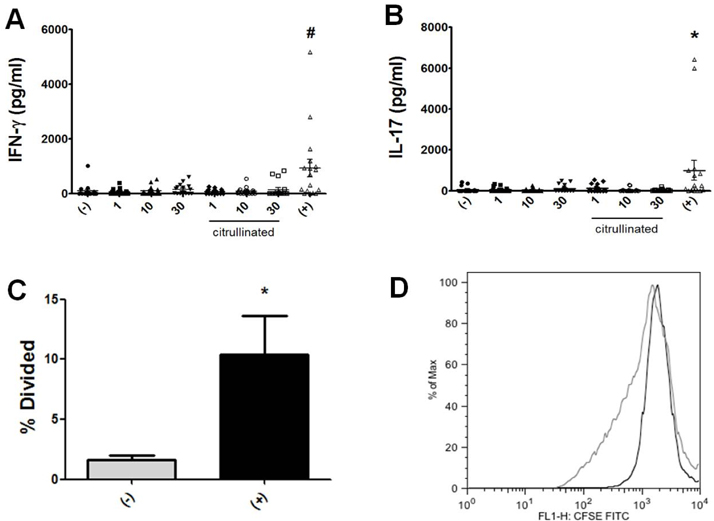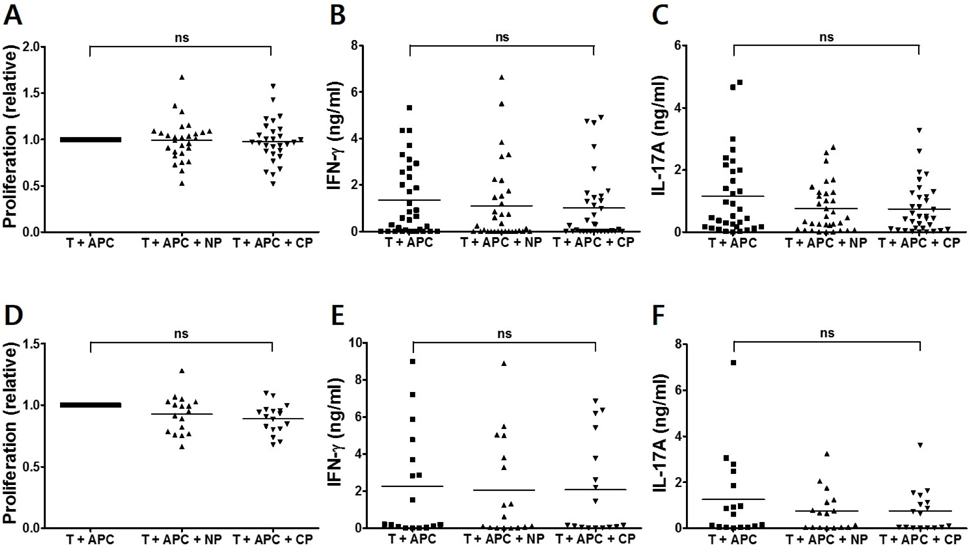Immune Netw.
2013 Aug;13(4):116-122. 10.4110/in.2013.13.4.116.
Role of Citrullinated Fibrinogen Peptides in the Activation of CD4 T Cells from Patients with Rheumatoid Arthritis
- Affiliations
-
- 1Graduate School of Medical Science and Engineering, Biomedical Research Center, KAIST Institute for the BioCentury, Korea Advanced Institute of Science and Technology, Daejeon 305-701, Korea. Seung-Hyo.Lee@kaist.ac.kr
- 2Division of Rheumatology, Department of Internal Medicine, Eulji Medi-Bio Research Institute, Eulji University, Daejeon 302-799, Korea.
- 3The Center for Rheumatic Diseases, Kangnam St. Mary's Hospital, and Rheumatism Research Center, College of Medicine, The Catholic University, Seoul 137-701, Korea.
- KMID: 2150776
- DOI: http://doi.org/10.4110/in.2013.13.4.116
Abstract
- This study was conducted to determine whether CD4 T cell responses to citrullinated fibrinogen occur in patients with rheumatoid arthritis (RA), especially in HLA-DR4-positive subjects. Whole peripheral blood mononuclear cells (PBMCs) of RA patients and control subjects were stimulated with citrullinated fibrinogen peptides, and T-cell production of proliferation and proinflammatory cytokines, such as interferon-gamma(IFN-gamma) and interleukin-17A (IL-17A), were measured. In addition, CD4 T cells from RA patients were stimulated with the citrullinated fibrinogen peptide, Fib-alpha R84Cit, identified as a DRB1*0401-restricted T cell epitope in HLA-DR4 transgenic mice, and the degree of T cell activation was examined similarly. No proliferative responses to the citrullinated fibrinogen peptides were observed in whole PBMCs or CD4 T cells from RA patients. Furthermore, no increased production of IFN-gamma or IL-17A was found in whole PBMCs or CD4 T cells stimulated with the citrullinated fibrinogen peptides, although these cells responded to recall antigen, a mixture of tetanus toxoid, purified protein derivative (PPD) from Mycobacterium tuberculosis, and Candida albicans. The results of this study indicate that anti-citrulline immunity in RA patients may be mediated by fibrinogen because there is no evidence of CD4 T cell-mediated immune responses to citrullinated fibrinogen peptides.
Keyword
MeSH Terms
Figure
Reference
-
1. Klareskog L, Catrina AI, Paget S. Rheumatoid arthritis. Lancet. 2009; 373:659–672.
Article2. Imboden JB. The immunopathogenesis of rheumatoid arthritis. Annu Rev Pathol. 2009; 4:417–434.
Article3. Klareskog L, Ronnelid J, Lundberg K, Padyukov L, Alfredsson L. Immunity to citrullinated proteins in rheumatoid arthritis. Annu Rev Immunol. 2008; 26:651–675.
Article4. Kuhn KA, Kulik L, Tomooka B, Braschler KJ, Arend WP, Robinson WH, Holers VM. Antibodies against citrullinated proteins enhance tissue injury in experimental autoimmune arthritis. J Clin Invest. 2006; 116:961–973.
Article5. van der Helm-van Mil AH, Verpoort KN, Breedveld FC, Huizinga TW, Toes RE, de Vries RR. The HLA-DRB1 shared epitope alleles are primarily a risk factor for anti-cyclic citrullinated peptide antibodies and are not an independent risk factor for development of rheumatoid arthritis. Arthritis Rheum. 2006; 54:1117–1121.
Article6. Hill JA, Southwood S, Sette A, Jevnikar AM, Bell DA, Cairns E. Cutting edge: the conversion of arginine to citrulline allows for a high-affinity peptide interaction with the rheumatoid arthritis-associated HLA-DRB1*0401 MHC class II molecule. J Immunol. 2003; 171:538–541.
Article7. Wegner N, Lundberg K, Kinloch A, Fisher B, Malmström V, Feldmann M, Venables PJ. Autoimmunity to specific citrullinated proteins gives the first clues to the etiology of rheumatoid arthritis. Immunol Rev. 2010; 233:34–54.
Article8. Takizawa Y, Suzuki A, Sawada T, Ohsaka M, Inoue T, Yamada R, Yamamoto K. Citrullinated fibrinogen detected as a soluble citrullinated autoantigen in rheumatoid arthritis synovial fluids. Ann Rheum Dis. 2006; 65:1013–1020.
Article9. Hill JA, Bell DA, Brintnell W, Yue D, Wehrli B, Jevnikar AM, Lee DM, Hueber W, Robinson WH, Cairns E. Arthritis induced by posttranslationally modified (citrullinated) fibrinogen in DR4-IE transgenic mice. J Exp Med. 2008; 205:967–979.
Article10. Arnett FC, Edworthy SM, Bloch DA, Mcshane DJ, Fries JF, Cooper NS, Healey LA, Kaplan SR, Liang MH, Luthra HS, Medsger TA Jr, Mitchell DM, Neustadt DH, Pinals RS, Schaller JG, Sharp JT, Wilder RL, Hunder GG. The American Rheumatism Association 1987 revised criteria for the classification of rheumatoid arthritis. Arthritis Rheum. 1988; 31:315–324.
Article11. Jordan F, McWhinnie AJ, Turner S, Gavira N, Calvert AA, Cleaver SA, Holman RH, Goldman JM, Madrigal JA. Comparison of HLA-DRB1 typing by DNA-RFLP, PCR-SSO and PCR-SSP methods and their application in providing matched unrelated donors for bone marrow transplantation. Tissue Antigens. 1995; 45:103–110.
Article12. Hammer J, Bono E, Gallazzi F, Belunis C, Nagy Z, Sinigaglia F. Precise prediction of major histocompatibility complex class II-peptide interaction based on peptide side chain scanning. J Exp Med. 1994; 180:2353–2358.
Article13. Huizinga TW, Amos CI, van der Helm-van Mil AH, Chen W, van Gaalen FA, Jawaheer D, Schreuder GM, Wener M, Breedveld FC, Ahmad N, Lum RF, de Vries RR, Gregersen PK, Toes RE, Criswell LA. Refining the complex rheumatoid arthritis phenotype based on specificity of the HLA-DRB1 shared epitope for antibodies to citrullinated proteins. Arthritis Rheum. 2005; 52:3433–3438.
Article14. Nakayama-Hamada M, Suzuki A, Kubota K, Takazawa T, Ohsaka M, Kawaida R, Ono M, Kasuya A, Furukawa H, Yamada R, Yamamoto K. Comparison of enzymatic properties between hPADI2 and hPADI4. Biochem Biophys Res Commun. 2005; 327:192–200.
Article15. Feitsma AL, van der Voort EI, Franken KL, el Bannoudi H, Elferink BG, Drijfhout JW, Huizinga TW, de Vries RR, Toes RE, Ioan-Facsinay A. Identification of citrullinated vimentin peptides as T cell epitopes in HLA-DR4-positive patients with rheumatoid arthritis. Arthritis Rheum. 2010; 62:117–125.
Article16. von Delwig A, Locke J, Robinson JH, Ng WF. Response of Th17 cells to a citrullinated arthritogenic aggrecan peptide in patients with rheumatoid arthritis. Arthritis Rheum. 2010; 62:143–149.
Article
- Full Text Links
- Actions
-
Cited
- CITED
-
- Close
- Share
- Similar articles
-
- Clinical Significance of Anti-Cyclic Citrullinated Peptide Antibodies and IgM Rheumatoid Factor in Rheumatoid Arthritis Patients
- Anti-citrullinated protein antibodies in rheumatoid arthritis: a bridge between genetic predisposition and autoimmunity
- Association of Anti-cyclic Citrullinated Peptide (CCP) Antibodies and Functional Status in Rheumatoid Arthritis
- Diagnostic Accuracies of Anti-carbamylated and Anti-citrullinated Fibrinogen Antibodies in Rheumatoid Arthritis: A Meta-analysis
- Diagnostic Performances of Anti-Cyclic Citrullinated Peptides Antibody and Antifilaggrin Antibody in Korean Patients with Rheumatoid Arthritis




